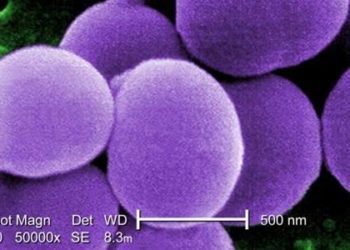Outer glove exchange and paper surgical gowns decrease bacterial contamination
Image: PD
1. Surgeons who retained their outer glove 1 hour into the case had higher glove contamination rate than surgeons who exchanged their outer glove (23% vs 13%).
2. Cloth gowns had a higher rate of baseline bacterial contamination (40.6% vs 12.9%) than paper gowns, and had higher rate of bacterial transmission through the material.
Evidence Rating Level: 1 (Excellent)
Study Rundown: Perioperative infections are a source of surgical complications. Many strategies have been suggested to reduce the rate of infection. Surgeons often use a double-glove technique and exchange the outer glove before handling a prosthesis, but this practice has not been validated, nor has the selection of the surgical gown material. This study attempts to examine the rate of bacterial contamination with respect to surgical gown material and outer glove exchange, and demonstrates a lower rate of baseline contamination as well as lower bacterial transmission through the gown with paper gowns. It also found a lower rate of contamination with outer glove exchange 1 hour into the case. One weakness of this study is the selection of a primary endpoint that is not patient oriented, as it examined contamination cultures instead of infection or complication rates. The study would likely be underpowered to detect a difference in infection rates. Moreover, the method of measuring bacterial transmission through gown material was artificial, using gowns mounted to sterilized buckets and inoculating a suspension of Staphylcoccus epidermis, which may not be a good simulation of actual surgical conditions. Finally, the study uses odds ratios to report outcome, which may overstate the effect, since the outcomes are not rare events.
Click to read the study in Annals of Surgery
Relevant Reading: Efficacy of double-gloving as a barrier to microbial contamination during total joint arthroplasty
In-depth: This paper examines three studies. The Glove 1 study randomized 102 surgical team members to exchange or not exchange their outer pair of gloves at 1 hour into an orthopedic surgical procedure. Swabs were taken from the surgical gown sleeve as well as the palm of their gloved hand. Repeat swabs were taken from team members randomized to exchange their outer glove. The Gown Strike-Through study was performed by suspending sterile reusable and non-reusable gowns to the rims of sterilized buckets. A Staphylcoccus epidermis bacterial suspension was pipetted to the center of the affixed gown. A culture plate was touched firmly to the opposite side of the gown at 5 minutes and analyzed for growth. The Glove 2 study was performed in the exact manner as the Glove 1 study, except all surgical team members were required to wear disposable paper gowns.
In the Glove 1 study, there was no statistically significant difference in glove or sleeve contamination between the glove exchange group and the control group. However, there was a significant difference found between the baseline gown contamination rate between paper gowns and cloth gowns (OR 4.64, 95% CI 1.72-12.53). In the Gown Strike-Through study, 26 of 27 cloth gowns allowed transmission of bacteria, whereas 0 of 27 disposable paper gowns allowed transmission of bacteria. In the Glove 2 study, the group members who kept their outer glove had a higher rate of being contaminated than those who exchanged their outer glove (OR 1.97, 95% CI 1.02-3.80).
By James Jiang and Allen Ho
More from this author: Laparoscopic hernia repair linked with lower rate of surgical infection, Study suggests general surgery residency graduates unprepared for fellowship, NEXUS Chest decision criteria sensitive for thoracic injury, Mortality after trauma increasingly due to preexisting conditions, Physical examination sufficient to evaluate abdominal stab wounds
© 2013 2minutemedicine.com. All rights reserved. No works may be reproduced without expressed written consent from 2minutemedicine.com. Disclaimer: We present factual information directly from peer reviewed medical journals. No post should be construed as medical advice and is not intended as such by the authors, editors, staff or by 2minutemedicine.com. PLEASE SEE A HEALTHCARE PROVIDER IN YOUR AREA IF YOU SEEK MEDICAL ADVICE OF ANY SORT.







